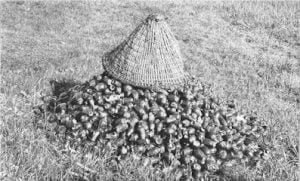The basketful of spokwas as it is brought from the boat is emptied into a pit dug in the ground for the purpose, to which each successive day’s harvest of spokwas is added. The disintegrating pods undergo some process of fermentation, which changes them into a mucilaginous liquid mass having the texture of a thin but very elastic dough. The pits are commonly 1½ to 2 feet in both diameter and depth. The top is covered with grass, tales, or an empty grain sack. These holes may be found anywhere about a wokas camp, and from the inconspicuous character of their covering, among the miscellaneous furniture of an Indian’s summer camp, it is altogether too easy to step into one. If a motto were to be suggested for visitors, it might well be: Let the stranger in a wokas camp beware of the spokwas hole.

Other cases were observed in which an old dugout, a large spokwas basket, a grain sack, or even a wooden box was used as the fermenting receptacle for spokwas. Large holes plug themselves with pieces of the pods and small ones are sealed by the drying of the mucilaginous contents. In every case the receptacle was shaded, a fact which, taken with the limited diameter of the receptacle or pit, which never exceeded 2 feet, suggested that the contents were liable, under adverse conditions, to overfermentation and heating.
At the end of the period of harvesting by any individual, whether it is one week or five weeks, the contents of the spokwas pits are dipped out and placed in a dugout. Water is then poured in, the whole mass stirred, and the coarser portions squeezed with the hands, much as curdled milk is manipulated in a cheese vat. The seeds, no longer held in suspension in the mucilage, drop to the bottom, and the floating refuse, mucilage, and water are removed by skimming, by rocking the boat, and by baling. The wet seeds, with a small amount of mucilage and occasional small scraps of pod adhering, are scooped from the boat and spread on a tale mat (shap’ss) in the sun to drain. They are then ready for manufacture into lolensh and subsequently into shnaps.
